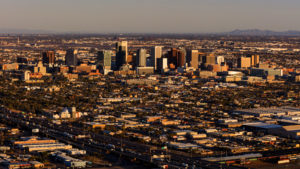
Five new high-rise buildings quietly poked into the downtown skyline over the past few years. Three more are nearing completion, and six more are ready to come out of the ground before the end of the year. There are more in the pipeline.
Three years in a row, Phoenix has been America’s fastest growing city. According to U.S. Census estimates, last year an average of 97 people every day chose to make a new home in the city.
One big change over the past ten years is that Phoenix has become America’s fifth-largest city. While it still trails the Boston metro by 80,000 people, the Phoenix metro is poised to move into position as a top 10 metro area. This puts the Valley into the major leagues. Phoenix is the youngest city among the top 25, and has climbed to its peak faster than any other city in the past century.
Area business leaders always used to say, “Phoenix builds itself out of a recession.” And Arizona economic history backed the theory. The economy tumbled, and when it turned upward again, people elsewhere sold homes, moved to the Valley and construction started pumping the local economy skyward once again. Arizona’s economy plummeted more than the nation, and its recovery skyrocketed above national norms. Time after time, until 2008.
The solution was to shift the Phoenix economy back to what it had been in the 1970s: a heavy production-focused economy. This was the silicon desert before there was a Silicon Valley. Nearly anything in the air had a part made in Arizona.
It’s still amusing to see the breathless media coverage about Phoenix leading the nation in construction hiring in 2019. As of May, there were 37,000 fewer metro construction workers today than there were at the pre-recession employment peak. In today’s Phoenix metro, the workforce has increased by 492,300 jobs since the bottom of the recession; that’s more than double the number of jobs lost between the 2007 employment peak and the 2010 recession trough.
What’s not readily recognized is the sectors benefitting from new jobs changed the Phoenix economy a lot since 2007. Bioscience and health care hiring increased by almost 100,000 jobs, according to state employment numbers from U.S. Bureau of Labor Statistics. Hiring never faltered during the recession. Since the recession-bottom, financial services and financial technology sectors increased by nearly 60,000 jobs. Manufacturing increased by nearly 22,000 jobs since the trough.
The pivot among job sectors is also visible in the jump in Valley wages. The rapid increase in hiring in the advanced industry sectors over the past three years has boosted the metro median wage. The Bureau of Economic Analysis shows that the Phoenix median wages have increased just over 12% since 2016. Among the top 25 metros, the Valley boasted a nation-leading 7.6 % jump in 2017 and a healthy 4.6% in 2018. Last year, Phoenix was highest among major metros in the 12 Western states. For the first time, Phoenix’s median wage is higher than the U.S. median wage.
A city of neighborhoods, it’s hard to think of Phoenix in a class with New York, Los Angeles, Chicago, and Houston. Yet, here it is—the third Western city to hit the top five. When the metro moves into the top 10, possibly next year, it will be the fourth Western metro in that class. The reaming six slots will be filled with three from the Northeast, two from the South and only one from the Midwest. Most still think of Phoenix as a big small town.
Today, steady, sustainable population growth and sustainable job growth become reasons why Phoenix is hot.
-Written by Eric Jay Toll, Phoenix Community and Economic Development. получить займ на карту
buy over the counter medicines займ на карту моментально без отказазайм на карту от 18срочный займ оренбург веб-займвзять займ без процентовзайм манимен


